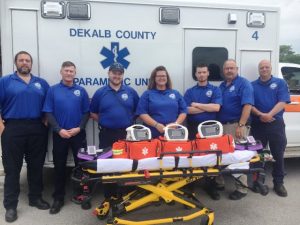May 17, 2018
By: Dwayne Page
The DeKalb County Ambulance Service is now better equipped to enhance the respiratory care of patients with the recent acquisition of three new ventilators and IntuBrite video laryngoscopes.
An Operations and Safety Grant, the amount of $24,000, from the Federal Emergency Management Agency’s Assistance to Firefighters Grant Program was awarded over a year ago to help purchase the equipment.
Hoyte Hale, local EMS Director, and Bradley Mullinax of the Emergency Communications District (911) applied for the grant two years ago. Hale explained that it took time to obtain and make use of the equipment after the grant was awarded because of the bidding process in making the purchase and due to the training that was required of the EMS staff.
“In 2016 I applied for an AFG grant with the help of Bradley Mullinax for ventilators and IntuBrite Video Laryngoscopes. We were awarded the grant in 2017 and then got bids on the equipment to purchase. We got a really good deal and were able to buy three ventilators instead of two. We even had money left over to buy the video Laryngoscopes. I am very proud that we got this grant awarded to us. It will help out the citizens of DeKalb County. When we take vent patients to Nashville it will help us provide a better quality of care for them,” said Hale.
Cody Johnson, a Critical Care Paramedic, explained how this upgrade in respiratory equipment will be a benefit to the ambulance service and to its patients.
“Ventilators allow paramedics to ventilate the patient with a more custom approach. Three year old pediatrics have different breathing needs than full grown adults and with that (ventilator) each patient is able to get a better rate of oxygen delivery. Once we get a patient stabilized and take them to the nearest hospital, if their breathing ability is compromised and we have to breathe for the patients we are able to place them on a ventilator and after they are stabilized at a local hospital, we are able to transfer them to a higher level of care. With the ventilator, it allows paramedics more time to better calculate medicines and to reassess the patients all without having to worry so much about making sure the patient is getting the proper amount of oxygen and proper ventilation rate,” said Johnson.
“We also now have video laryngoscopes. With a normal classis laryngoscope, a paramedic is able to place the device into the patient’s mouth and it lifts up their tongue and epiglottis so that when he inserts an intubation tube to get perfect access to the patient’s lungs he can get a direct visual on the vocal chords. With a video laryngoscope, the paramedic is able to see around the tongue a lot easier and a lot better for patients that may have a bigger tongue or who is really hard to intubate for any number of reasons. With this we’re able to see around the tongue and intubate a lot easier better confirming that we have a good airway when transporting a patient,” added Johnson.




